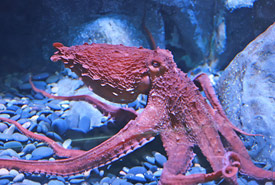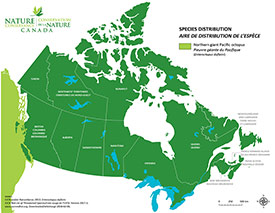
Northern giant Pacific octopus (Photo by Karen/Wikimedia Commons)
Northern giant Pacific octopus
The northern giant Pacific octopus (Enteroctopus dofleini) is the largest, longest-lived octopus species. Although its average length and mass are 5 metres and 20 to 50 kilograms respectively, the largest recorded individual was 9.1 metres long and weighed 272 kilograms. They typically live for three to five years. Like other octopus species, the northern giant Pacific octopus is very smart and some have been known to open jars and complete mazes.
What does the northern giant Pacific octopus look like?
This cephalopod mollusc has a soft, reddish-brown body and a large, globular head. The mantle (membrane) that covers its body cavity is encircled by eight tentacles (arms), each with two rows of suckers underneath.
Where does the northern giant Pacific octopus live?
This species inhabits temperate northern Pacific waters ranging from California to British Columbia, and from Alaska to Japan. It lives in naturally occurring caves with tight openings in intertidal zones and in waters up to 100 metres deep.
What are the northern giant Pacific octopus's adaptations?
This animal is both a master of disguise and an escape artist. Special skin pigments called chromatophores allow it to change colour and texture to match surrounding organisms and objects, such as coral, plants and rocks. When threatened, it contracts its mantle muscles, pumping water from its body through a funnel tube to create jet propulsion for a speedy getaway. It can also expel a black ink substance through its siphon.
What does the northern giant Pacific octopus eat?
This nocturnal predator typically preys on crustaceans (e.g. crabs), other molluscs (e.g. clams) and small fish, occasionally eating sharks and birds. It uses venom produced in its salivary glands to paralyze prey and its sharp beak to pierce and rip through flesh and break open crustaceans’ exoskeletons.
How does the northern giant Pacific octopus breed?
The male uses an arm with a groove to insert a spermatophore (a clear, jelly-like, sperm-filled packet) into one of the female’s intake ports. After mating, the female looks for a suitable egg-laying spot, typically a cave with a tiny opening. She will then lay thousands of white, rice grain-sized eggs along her den’s ceiling. She guards her eggs until they hatch four to six months later, never leaving them unattended, not even to eat. Shortly after breeding, both sexes die.
What is the northern giant Pacific octopus's conservation status?
Population numbers of this species are unknown, but it is secure and common in the waters off of British Columbia’s coast. However, it is sensitive to its surrounding environment and could be adversely impacted by pollution and climate change.






